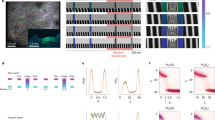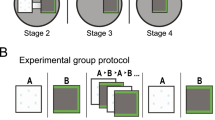Abstract
This paper presents a possible context-sensitive mechanism in a neural network and at single neuron levels based on the experiments of hippocampal CA1 and their theoretical models. First, the spatiotemporal learning rule (STLR, non-Hebbian) and the Hebbian rule (HEBB) are experimentally shown to coexist in dendrite–soma interactions in single hippocampal pyramidal cells of CA1. Second, the functional differences between STLR and HEBB are theoretically shown in pattern separation and pattern completion. Third, the interaction between STLR and HEBB in neural levels is proposed to play an important role in forming a selective context determined by value information, which is related to expected reward and behavioral estimation.
Similar content being viewed by others
References
Aihara, T., Tsukada, M., Crair, M. C., & Sinomoto, S. (1997). Stimulus-dependent induction of long-term potentiation in CA1 area of the hippocampus: experiment and model. Hippocampus, 7, 416–426.
Aihara, T., Kobayashi, Y., Matsuda, H., Sasaki, H., & Tsukada, M. (1998). Optical imaging of LTP and LTD induced simultaneously by temporal stimulus in hippocampal CA1 area. Soc. Neurosci. Abstr., 24, 1070.
Aihara, T., Tsukada, M., & Matsuda, H. (2000). Two dynamic processes for the induction of long-term in hippocampal CA1 neurons. Biol. Cybern., 82, 189–195.
Bi, G., & Poo, M. (1998). Synaptic modifications in cultured hippocampal neurons: Dependence on spike timing, synaptic strength, and postsynaptic type. J. Neurosci., 18, 10464–10472.
Bland, B. H., Jackson, J., Derrie-Gillespie, D., Azad, T., Rickhi, A., & Abriam, J. (2006). Amplitude, frequency, and phase analysis of hippocampal theta during sensorimotor processing in a jump avoidance task. Hippocampus, 16, 673–681.
Bliss, T. P., & Lømo, T. (1973). Long-lasting potentiation of synaptic transmission in the dentate area of the anesthetized rabbit following stimulation of perforant path. J. Physiol., 232, 331–356.
Boettiger, C. A., & Doupe, A. J. (2001). Developmentally restricted synaptic plasticity in a songbird nucleus required for song learning. Neuron, 31, 809–818.
Buzsaki, G., Leung, L., & Vanderwolf, C. H. (1983). Cellular bases of hippocampal EEG in the behaving rat. Brain Res. Rev., 6, 169–171.
Csicsvari, J., Jamieson, B., Wise, K. D., & Buzsaki, G. (2003). Mechanisms of gamma oscillations in the hippocampus of the behaving rat. Neuron, 37, 311–322.
Debanne, D., & Thompson, S. M. (1998). Associative long-term depression in the hippocampus in vitro. Hippocampus, 6, 9–16.
Feldman, D. E. (2000). Timing based LTP and LTD at vertical inputs to layer II/III pyramidal cells in rat barrel cortex. Neuron, 27, 45–56.
Fregnac, Y., & Shulz, D. (1994). Models of synaptic plasticity and cellular analogs of learning in the developing and adult vertebrate visual cortex. In Casagrande, V., & Shinkman, P. (Eds.), Advances in neural and behavioral development (pp. 149–235). Norwood: Ablex.
Froemke, R. C., & Dan, Y. (2002). Spike-timing-dependent synaptic modification induced by natural spike trains. Nature, 416, 433–438.
Fukushima, Y., Tsukada, M., Tsuda, I., Yamaguti, Y., & Kuroda, S. (2007). Spatial clustering property and its self-similarity in membrane potentials of hippocampal CA1 pyramidal neurons for a spatiotemporal input sequence. Cogn. Neurodyn., 1, 305–316.
Golding, N. L., Staff, N. P., & Spruston, N. (2002). Dendritic spikes as a mechanism for cooperative long-term potentiation. Nature, 418, 326–331.
Hasselmo, M. (1999). Neuromodulation: Acetylcholine and memory consolidation. Trends Cogn. Sci., 3, 351–359.
Hasselmo, M. (2006). The role of acetylcholine in learning and memory. Curr. Opin. Neurobiol., 16, 710–715.
Hebb, D. O. (1949). The organization of behavior. New York: Wiley.
Ihalainen, J. A., Riekkinen, P. J., & Feenstra, M. G. (1999). Comparison of dopamine and noradrenaline release in mouse prefrontal cortex, striatum and hippocampus using microdialysis. Neurosci. Lett., 277, 71–74.
Kay, J., & Phillips, W. A. (1997). Activation functions, computational goals and learning rules for local processors with contextual guidance. Neural Comput., 9, 895–910.
Li, S., Cullen, W. K., Anwyl, R., & Rowan, M. J. (2003). Dopamine-dependent facilitation of LTP induction in hippocampal CA1 by exposure to spatial novelty. Nat. Neurosci., 6, 526–531.
Lisman, J. E. (1989). A mechanism for Hebb and the anti-Hebb processes underlying learning and memory. Proc. Natl. Acad. Sci. USA, 86, 9574–9578.
Lisman, J. E., & Grace, A. A. (2005). The hippocampal-VTA loop: Controlling the entry of information into long-term memory. Neuron, 46, 703–713.
Magee, J. C., & Johnston, D. (1997). A synaptically controlled, associative signal for Hebbian plasticity in hippocampal neurons. Science, 275, 209–213.
Markram, H., Lubke, J., Frotscher, M., & Sakmann, B. (1997). Regulation of synaptic efficacy by coincidence of postsynaptic APs and EPSPs. Science, 275, 213–215.
Nakazawa, K., Quirk, M. C., Chitwood, R. A., Watanabe, M., Yeckel, M. F., Sun, L. D., Kato, A., Carr, C. A., Johnston, D., Wilson, M. A., & Tonegawa, S. (2002). Requirement for hippocampal CA3 NMDA receptors in associative memory recall. Science, 297, 211–218.
Reynolds, J. N., & Wickens, J. R. (2002). Dopamine-dependent plasticity of corticostriatal synapses. Neural Netw., 15, 507–521.
Sainsbury, R. S., Heynen, A., & Montoya, C. P. (1987). Behavioral correlates of hippocampal type 2 theta in the rat. Physiol. Behav., 39, 513–519.
Scheiderer, C. L., Smith, C. C., McCutchen, E., McCoy, P. A., Thacker, E. E., Kolasa, K., Dobrunz, L. E., & McMahon, L. L. (2008). Coactivation of M(1) muscarinic and alpha1 adrenergic receptors stimulates extracellular signal-regulated protein kinase and induces long-term depression at CA3-CA1 synapses in rat hippocampus. J. Neurosci., 28, 5350–5358.
Shinoe, T., Matsui, M., Taketo, M., & Manabe, T. (2005). Modulation of synaptic plasticity by physiological activation of M1 muscarinic acetylcholine receptors in the mouse hippocampus. J. Neurosci., 25, 11194–11200.
Sjöström, P. J., Turrigiano, G. G., & Nelson, S. B. (2001). Rate timing and cooperativity jointly determine cortical synaptic plasticity. Neuron, 32, 1149–1164.
Sourdet, V., & Debanne, D. (1999). The role of dendritic. Filtering in associative long-term synaptic. Plasticity Learn. Mem., 6, 422–447.
Stegeren, A. H. (2008). The role of the noradrenergic system in emotional memory. Acta Psychol. (Amst.), 127, 532–541.
Takahashi, M., Lauwereyns, J., Sakurai, Y., & Tsukada, M. (2009). A code for spatial alternation during fixation in rat hippocampal CA1 neurons. J. Neurophysiol., 102, 556–567.
Thomas, M. J., Watabe, A. M., Moody, T. D., Makhinson, M., & O’Dell, T. J. (1998). Postsynaptic complex spike bursting enables the induction of LTP by theta frequency synaptic stimulation. J. Neurosci., 18, 7118–7126.
Tsubokawa, H., & Ross, W. M. (1997). Muscarinic modulation of spike back-propagation in the apical dendrites of hippocampal CA1 pyramidal neurons. J. Neurosci., 17, 5782–5791.
Tsuda, I. (1996). A new type of self-organization associated with chaotic dynamics in neural networks. Int. J. Neural Syst., 7, 451–459.
Tsuda, I. (2001). Toward an interpretation of dynamic neural activity in terms of chaotic dynamical systems. Behav. Brain Sci., 24, 793–847.
Tsukada, M., Aihara, T., Mizuno, M., Kato, H., & Ito, K. (1994). Temporal pattern sensitivity of long-term potentiation in hippocampal CA1 neurons. Biol. Cybern., 70, 495–503.
Tsukada, M., Aihara, T., Saito, H., & Kato, H. (1996). Hippocampal LTP depends on spatial and temporal correlation of inputs. Neural Netw., 9, 1357–1365.
Tsukada, M., & Pan, X. (2005). The spatiotemporal learning rule and its efficiency in separating spatiotemporal patterns. Biol. Cybern., 92, 139–146.
Tsukada, M., Yamazaki, Y., & Kojima, H. (2007). Interaction between the Spatio-Temporal Learning Rule (STLR) and Hebb type (HEBB) in single pyramidal cells in the hippocampal CA1 Area. Cogn. Neurodyn., 1, 1157–1167.
Watabe, A. M., Zaki, P. A., & O’Dell, T. J. (2000). Coactivation of beta-adrenergic and cholinergic receptors enhances the induction of long-term potentiation and synergistically activates mitogen-activated protein kinase in the hippocampal CA1 region. J. Neurosci., 20, 5924–5931.
Zhang, L. I., Tao, H. W., Holt, C. E., Harris, W. A., & Poo, M. (1998). A critical window for cooperation and competition among developing retinotectal synapses. Nature, 395, 37–44.
Author information
Authors and Affiliations
Corresponding author
Rights and permissions
About this article
Cite this article
Tsukada, M., Fukushima, Y. A Context-Sensitive Mechanism in Hippocampal CA1 Networks. Bull Math Biol 73, 417–435 (2011). https://doi.org/10.1007/s11538-010-9566-8
Received:
Accepted:
Published:
Issue Date:
DOI: https://doi.org/10.1007/s11538-010-9566-8




